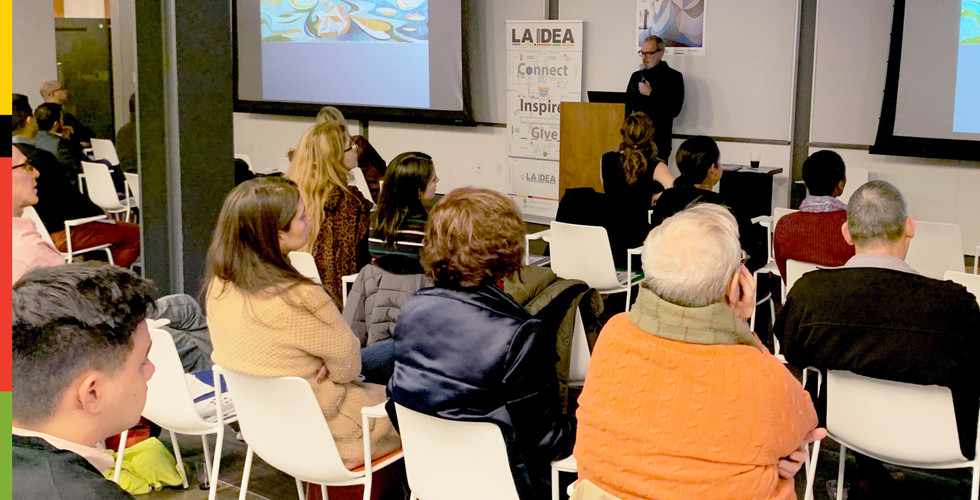Paulo Werneck, Brazilian Muralist: A Modernist Designer, presented by Gaspar Saldanha
On Tuesday, January 28, 2020 at the District Architecture Center, Gaspar Saldanha (a Brazilian-born and US-based designer), presented Paulo Werneck’s work to the DC community. The event was hosted by LA.IDEA (AIA|DC) and was well attended by industry professionals in the DMV area.

Paulo Werneck, a Brazilian muralist and modernist designer, was an influential contributor to the development of the modernist movement in Brazil and the larger Latin American region.

Saldanha, who happens to be Werneck’s grandson, has joined forces with his sister, Claudia, to promote and preserve their grandfather’s legacy. Werneck created over 300 mosaic murals in Brazil from 1942 to the late 1970s, but prior to this period he worked as a draftsman and an illustrator for architectural magazines and books. His renderings of the Press Association Building (ABI) for the prominent Roberto Brothers, won him national recognition. Werneck went on to collaborate with other celebrated artists, designers and architects like Oscar Niemeyer.
Click on the arrows to see more of Werneck's designs:
Saldanha shared impassioned and in-depth memories of his grandfather’s methodical and unique approach to creating mosaic murals, which eventually graced the walls of modernist buildings from Rio, to São Paolo, to the smaller agricultural towns of the interior. Werneck inter-played the figurative, abstract and geometric which culminated in iconic creations that have endured and remain an integral part of the Brazilian urban scape. Saldanha highlighted key projects including the mural clad terrace of the Brazil Reinsurance Institute (IRB) in 1944, and the side murals for the Pampulha Church in Belo Horizonte, the latter being a UNESCO World Heritage Site.
The presentation concluded with a question and answer session, one such question from the audience was whether Werneck used any special mathematical variations for his mosaic creations. Saldanha responded that Werneck was very methodical and organized, his production accentuated his craftsmanship and precision. Saldanha concluded by sharing some information about the foundation “Projecto Paulo Werneck”, which promotes and funds the restoration of Werneck’s works of art, thus preserving his contribution to the modernist movement in Brazil.
We would like to thank everyone who came to our event, our fellow committee members, our speaker, and of course our sponsors - EYP, Graphisoft, Florense and Porcelanosa.
Paulo Werneck, Brazilian Muralist: A Modernist Designer
Presented by: Gaspar Saldanha
Organized by: LA.IDEA AIA|DC
Sponsored by: EYP; Florense; Graphisoft; Porcelanosa

Click on the arrows to see more of event's photos:
Gaspar Saldanha, Brazilian-born, US-based, is renowned for his textiles. After studying Fine Arts and Industrial Design in Rio de Janeiro, he moved to New York City to specialize in textile design at the Fashion Institute of Technology. In the early nineties, Saldanha established his eponymous fashion brand, producing a line of menswear sold at prestigious stores such as Barneys and Bergdorf Goodman.
In 2008 he joined his sister in reviving the archives of their grandfather, the great Brazilian muralist Paulo Werneck. Since then Werneck’s work has been exhibited in foremost museums, such as: Paço Imperial (Rio de Janeiro), Pinacoteca (São Paulo), the Wolfsonian (Miami), America’s Society (New York) and Blanton Museum (Austin) in the US. Saldanha has presented lectures on Werneck’s work at various design institutions such as AIA New York, Florida University’s Urban Lab and ESDI Escola Superior de Desenho Industrial (Rio de Janeiro). Recently he supervised the reconstruction of Werneck’s first and largest work: seven mosaic murals for the terrace of Instituto de Resseguros do Brasil, a project from 1942 by the Roberto Brothers, with gardens by Burle Marx.
Currently living in Miami, Saldanha works on re-editions and reinterpretations of Werneck’s mosaic oeuvre: http://paulowerneck.org. He is also planning a coffee table book on Werneck’s acclaimed mosaics.




















































Comments